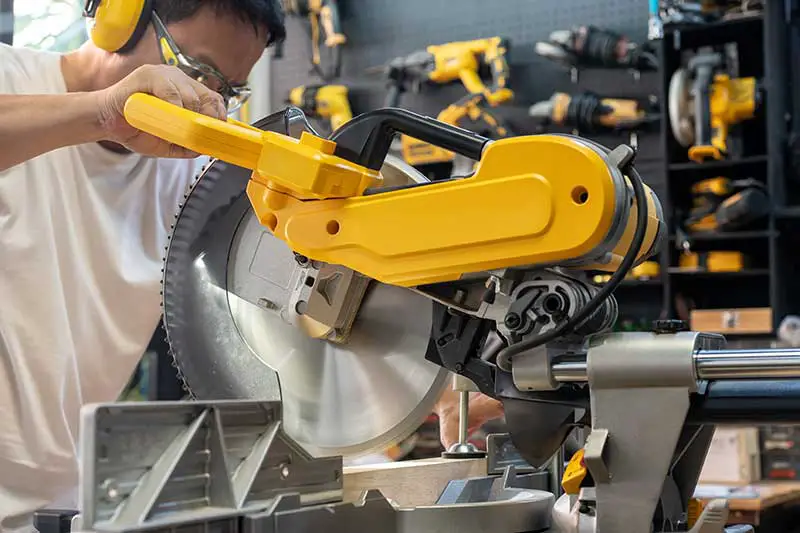A sliding miter saw is a versatile woodworking tool that combines the functions of a standard miter saw with a sliding mechanism, allowing for wider cuts and increased cutting capacity.

Introduction
Are you curious about what a sliding miter saw is and how it can transform your woodworking projects? In this article, we’ll dive deep into the world of sliding miter saws, exploring their features, benefits, and how to use them effectively. Whether you’re a DIY enthusiast or a professional woodworker, this guide is designed to provide you with valuable insights and practical tips to maximize your results.
What is a Sliding Miter Saw?
A sliding miter saw is a powerful woodworking tool that combines the functionality of a standard miter saw with the added feature of a sliding mechanism. This mechanism allows the saw to make wider cuts, increasing its versatility and making it a must-have for any serious woodworker.
Components of a Sliding Miter Saw
- Base: The sturdy platform that supports the entire saw and your workpiece.
- Table: The flat surface on which the workpiece is placed.
- Fence: The vertical support that helps to keep the workpiece in place.
- Miter Gauge: The adjustable guide that allows you to set precise angles for your cuts.
- Blade: The circular cutting disc with sharp teeth, responsible for slicing through the workpiece.
- Blade Guard: The protective cover that shields the blade when it’s not in use.
- Motor: The power source that drives the blade.
- Sliding Rails: The key feature that enables the saw to slide back and forth, allowing for wider cuts.
Benefits of a Sliding Miter Saw
Greater Cutting Capacity
A sliding miter saw’s extended cutting capacity makes it ideal for tackling large workpieces and wide boards. This increased range allows you to complete projects that would be challenging or impossible with a standard miter saw.
Improved Versatility
Sliding miter saws are perfect for a wide range of woodworking tasks, including crosscuts, miter cuts, bevel cuts, and compound cuts. This versatility makes them an excellent investment for any workshop.
Enhanced Precision
The sliding mechanism, combined with the adjustable miter gauge, allows for precise, accurate cuts every time. This level of accuracy is crucial when working on intricate projects or when making multiple identical cuts.
How to Choose the Right Sliding Miter Saw
Determine Your Needs
Consider the types of projects you plan to work on and the cutting capacity you require. This will help you choose the appropriate size and power of sliding miter saw for your needs.
Features to Look For
- Motor Power: A powerful motor ensures smooth, efficient cutting.
- Blade Size: Larger blades can handle bigger workpieces and make deeper cuts.
- Miter and Bevel Range: A wide range of angles allows for greater versatility.
- Positive Stops: Pre-set angle stops make it easy to quickly set up common cuts.
- Dust Collection: An effective dust collection system keeps your workspace clean and safe.
How to Use a Sliding Miter Saw Safely and Effectively
Safety First
- Wear proper safety gear, including eye and ear protection.
- Keep your hands away from the blade at all times.
- Use the blade guard and other safety features.
Proper Technique
- Secure the workpiece firmly against the fence and table.
- Set the desired miter and bevel angles.
- Start the saw and let it reach full speed before making a cut.
- Use a smooth, steady motion to slide the saw through the workpiece.
Maintaining Your Sliding Miter Saw
- Regularly clean: Remove dust and debris from the saw’s components to ensure smooth operation.
- Inspect: Check for loose parts, damaged components, or dull blades and address any issues promptly.
- Lubricate: Apply lubricant to the sliding rails and other moving parts as needed to reduce friction and wear.
- Sharpen or replace: Keep the blade sharp for optimal cutting performance, and replace it when necessary.
Common Issues and Troubleshooting Tips
Inaccurate Cuts
- Check blade alignment: Ensure the blade is parallel to the fence and perpendicular to the table.
- Verify miter and bevel settings: Double-check your angle settings before making a cut.
- Inspect blade: Make sure the blade is sharp and free from damage.
Excessive Vibration
- Inspect motor: Check for any loose or damaged components within the motor housing.
- Tighten bolts: Ensure all bolts and fasteners are securely tightened.
- Balance the saw: Place the saw on a level surface to prevent uneven weight distribution.
Popular Sliding Miter Saw Brands
- DEWALT
- Bosch
- Makita
- Milwaukee
- Hitachi
| Brand | Model | Motor Power | Blade Size | Miter Range | Bevel Range | Weight |
|---|---|---|---|---|---|---|
| DEWALT | DWS779 | 15 Amp | 12″ | 0-60° | 0-49° | 56 lbs |
| Bosch | GCM12SD | 15 Amp | 12″ | 0-60° | 0-47° | 65 lbs |
| Makita | LS1019L | 15 Amp | 10″ | 0-60° | 0-48° | 52 lbs |
Conclusion
A sliding miter saw is an invaluable addition to any woodworking arsenal, offering increased cutting capacity, versatility, and precision. By understanding its components, benefits, and proper usage, you can make informed decisions when purchasing and using this powerful tool. With the right sliding miter saw, your woodworking projects will become more efficient and enjoyable.
